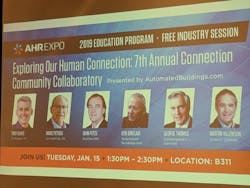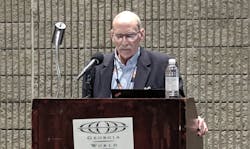AHR 2019: Notes from the 7th Annual Connection Community Collaboratory
ATLANTA, GA — On the second day of AHR Expo 2019, Ken Sinclair, the publisher of AutomatedBuildings.com invited a panel of experts from around the IoT and building automation industry to join him in discussing the latest and most significant developments in our “journey of digital transformation” as part of the Seventh Annual Connection Community Collaboratory
After thanking the attendees, Sinclair allowed each member of the panel to introduce themselves and offer a few thoughts on what they currently found interesting and exciting in the building automation space, and where they hoped those developments would lead in the years to come.
The panel included Marc Petock, Chief Marketing and Communications Officer for Lynxspring, Inc., a company offering building automation, energy management and system integration solutions to its clients; George Thomas, President of Contemporary Controls, an electronics manufacturer who partners with its customers in applying network solutions to automation projects; Troy Davis, Director of Sales for EnOcean, Inc., a company applying a patented energy harvesting technology for use in building automation and smart home control; and Martin Villenuve, President of Distech-Controls, a company that connects people with intelligent building solutions.
Marc Petock continued the discussion by noting that the common denominator in a lot of the emerging technology was that it was all generating vast amounts of data. How we will use this data and relate to it as humans is, he believes, the great challenge and opportunity of the coming years.
Petock describes 2018 as a threshold year. Now the conversation has shifted – away from IoT or IIoT or even integrated systems – to digital transformation. Now the human experience of the built environment is at the center of the discussion. Petock believes 2019 will be the “year of truth” for the built environment.
George Thomas in his opening remarks talked about the potential of the open software/open hardware movement, including Sedona and Raspberry Pi.
He made note that the U.S. now spends $513 billion on cloud computing alone, and that the fight over that money was now beginning in earnest. The “cloud wars” between Google, Amazon, IBM and other major players will involve huge companies throwing huge amounts of resources at each other to expand their share of the cloud computing marketplace.
Lastly, Thomas talked about disruption. There are a huge number of buildings that are not under BAS (building automation system) control, and that they might skip the BAS industry altogether (just as some nations skipped building phone lines for cell phone towers) and take their business direct to one of the cloud companies.
Troy Davis opened his remarks by speaking to the possibilities the present state of technology presented. Everything can be measured (light levels, temperature, humidity, air pressure and on and on), and nearly everything that can be measured can be adjusted to suit the occupants of a building.
But, the different sensors measuring different things are not talking to one another. If we only could have buildings with no people in them, just imagine, he joked, how easy they would be to manage!
However, the human component and the data component are starting to converge. And that also is the point where the buildings automation community must come together to take advantage of the data and use it to do remarkable things.
Martin Villenuve, like the speakers before him, stressed that the human connection must take center stage. So far, any building management system has had the same, boring, interface: a beige sensor box on the wall. That is what most people who are the actual occupants of buildings end up interacting with.
But that isn’t what people want. People want to interact via their smartphones, via Bluetooth, via voice control.
Villenuve belives the smartphone is going to become the new point of interface, which is going to open up a whole new world of possibilities. What if our phones always carried our temperature/humidity/lighting preferences and all the rooms of all the buildings around us automatically adjusted? What if a room “knew” how many occupants it had and could adjust the fresh air intake? That level of interactivity will work to enhance the level of human engagement as well as human comfort.
Villenuve also affirmed that I.P. (Indoor Positioning) is going to make its way into Building Management Systems. Soon it will connect us to a new generation of products which will once again enhance the occupant experience.
Then Ken Sinclair once more took the podium to offer some response. The smartphone, he agreed, is going to be a huge factor in BAS moving forward, however he saw a great deal of potential in “deviceless” interaction; voice- and machine vision-enabled devices that would predict our wants and needs. “Building emotion,” Sinclair called it, using “building” as both noun and verb.
To make that next step, he observed, a lot of the burden would fall on architects and building designers.
Master System Integrators, Sinclair said, will be the leaders in this new and exciting field, the people who will bring these many disparate systems together and connect them meaningfully.
The discussion continued on for another forty minutes, with observations, reactions and responses from the panel, often in agreement but at times in sharp contrast, as when George Thomas at one point said, “I think all this is technology going looking for problems to solve.”
All the panelists were in agreement on one thing: the security of private data is going to become a much greater concern to everyone involved, and much faster than anyone thinks.
The entire Connection Community Collaboratory can be viewed below.
About the Author
Steve Spaulding
Editor-in-Chief - CONTRACTOR
Steve Spaulding is Editor-in-Chief for CONTRACTOR Magazine. He has been with the magazine since 1996, and has contributed to Radiant Living, NATE Magazine, and other Endeavor Media properties.


